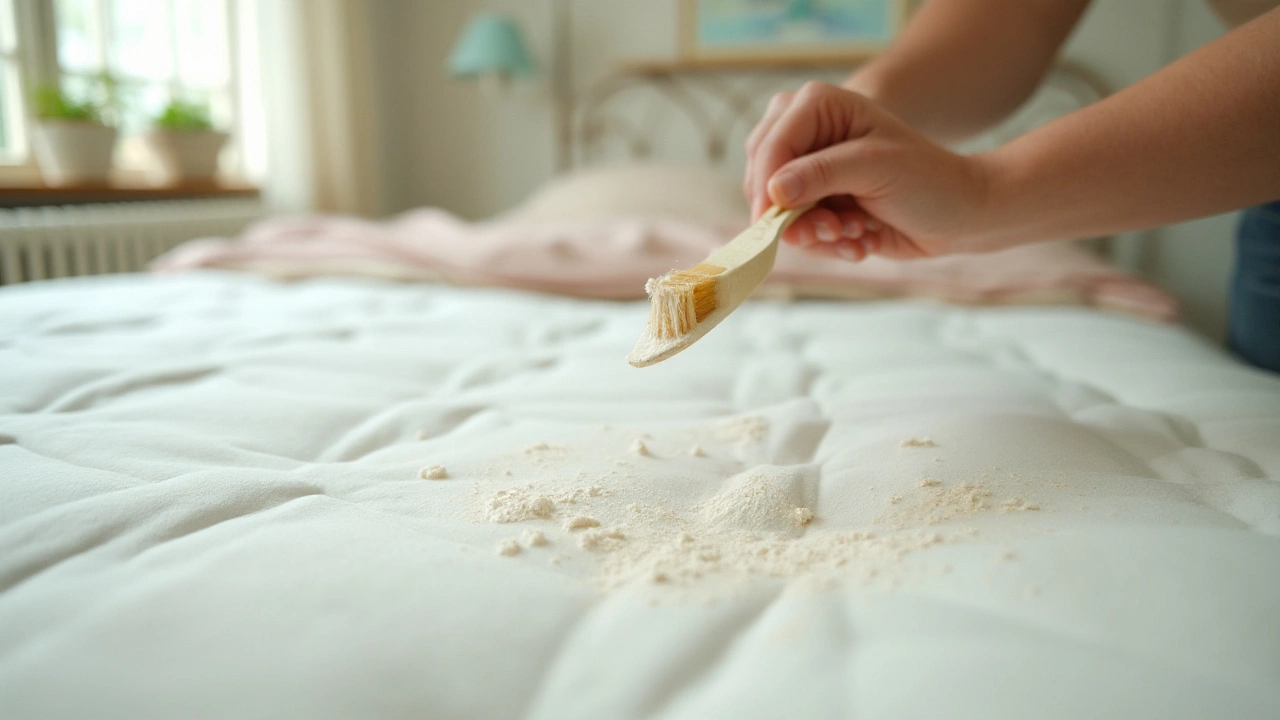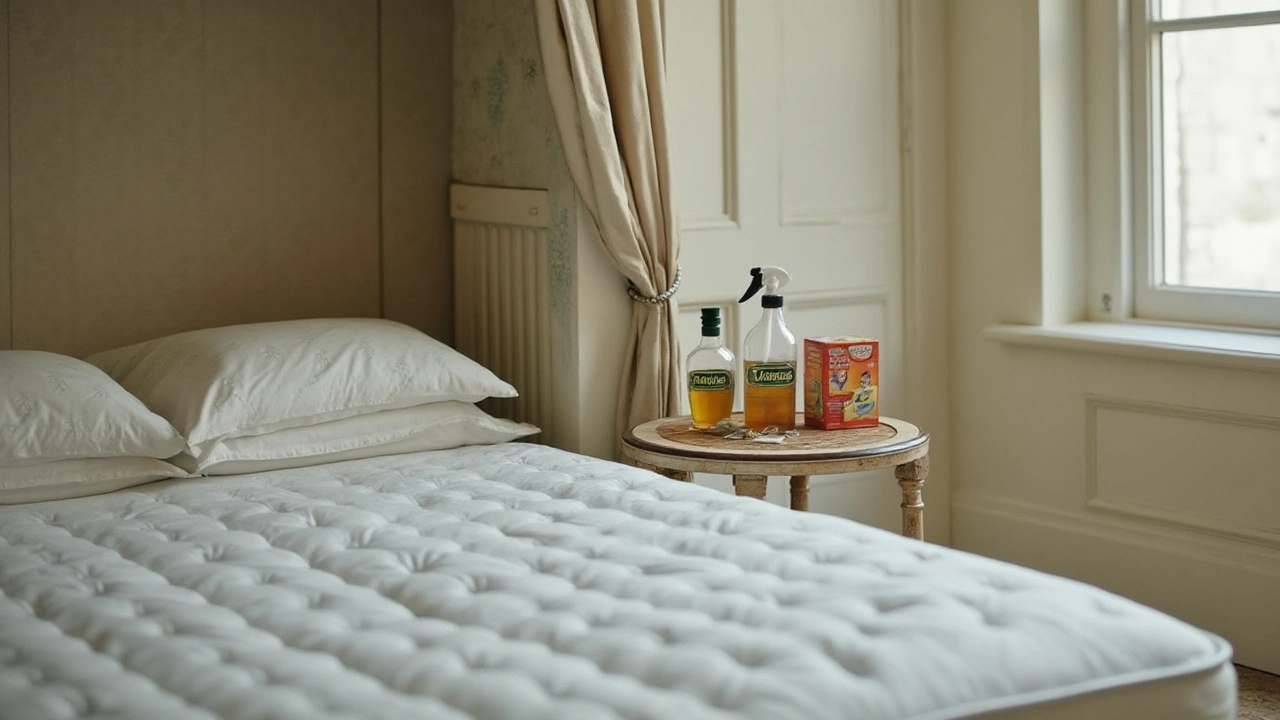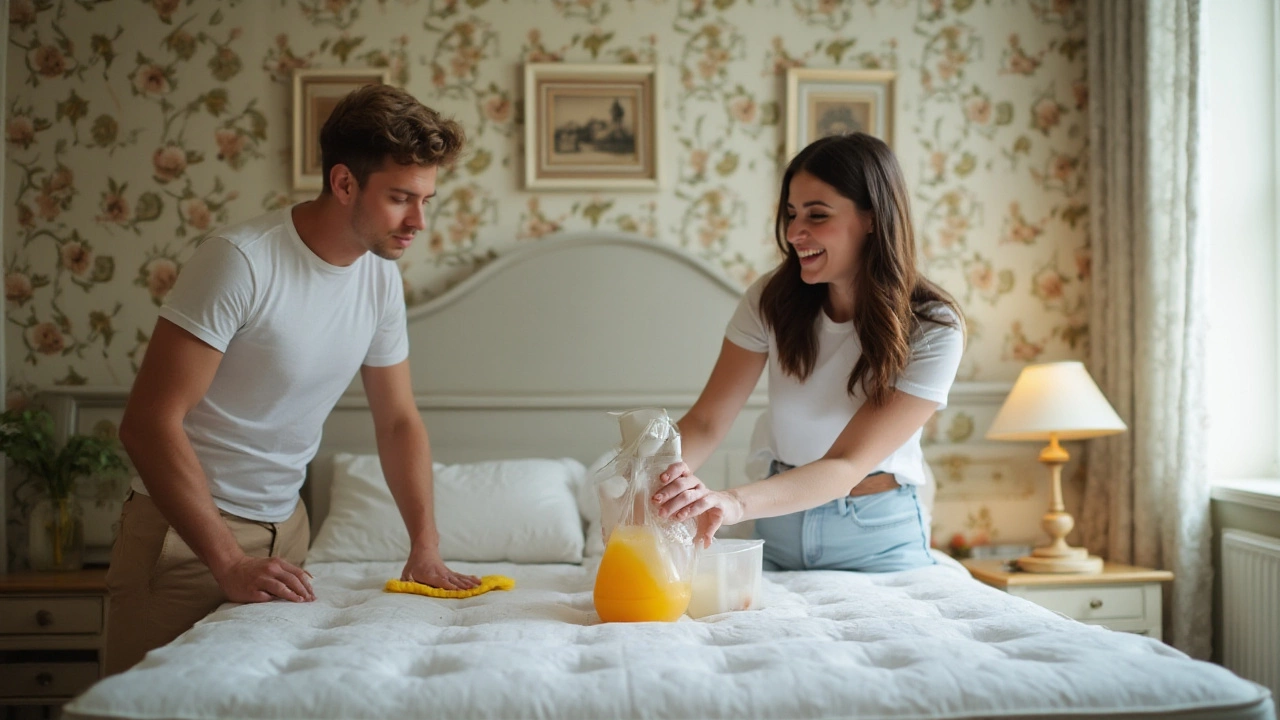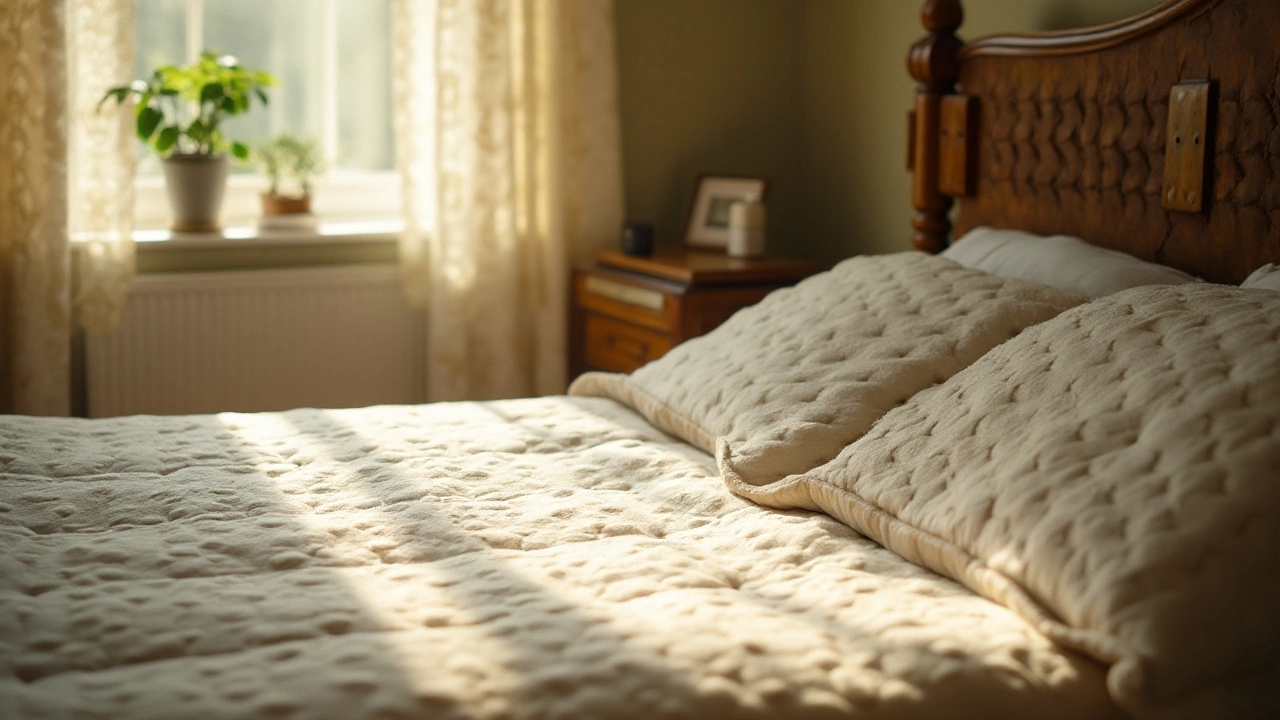Yellow stains on your mattress are more common than you might think, and they come from a variety of sources such as sweat, body oils, and time. These unsightly marks can make an otherwise clean mattress feel unpleasant, but don't worry, effective solutions are within reach.
Diving into some simple and effective home remedies, we'll explore how everyday household items like baking soda and vinegar can become your mattress's best friends. Say goodbye to harsh chemicals and discover methods that not only tackle those stubborn stains but also help extend the life of your mattress.
- Understanding the Causes of Yellow Stains
- DIY Solutions You Can Trust
- Preventing Future Stains
- Tips for Maintaining a Fresh Mattress
Understanding the Causes of Yellow Stains
Mattresses endure a lot over the years, taking the brunt of our nightly tosses and turns. It's no wonder they sometimes sport less-than-appealing yellow stains, a common household mystery that often goes unexplained. These unsightly marks primarily arise from a combination of sweat, body oils, dead skin cells, and, over time, these elements seep into the fabric, causing discoloration. The human body, it seems, produces nearly half a liter of sweat each night. This statistic alone gives a clue to the potential buildup that accumulates on our mattresses over time.
While sweat is a primary culprit, another factor can be moisture. Living in humid environments exacerbates this issue, as moisture gets trapped, fostering yellow stains. Moreover, if you’ve ever enjoyed a breakfast in bed or had a drink on your mattress, spills might contribute unknowingly to these stubborn marks. Another contributor is urine, particularly from pets or young children. Even after drying, such accidents can leave behind lingering discoloration and odors.
Smoking inside bedrooms is yet another underestimated cause. Nicotine from cigarettes clings to the mattress fabric, adding to the yellowish hue over time. Additionally, exposure to sunlight streaming through windows can oxidize these substances, intensifying the color. This oxidation process is not unlike the malaise we observe in antiques when exposed to light for extended periods.
The chemistry behind stain formation is surprisingly intricate. According to a study by the Sleep Products Safety Council, untreated stains can lead to bacteria and even mold growth within the mattress. Not only does this ruin aesthetics, but it compromises the bed’s hygiene too. Let's not forget that such stains could potentially attract dust mites, which thrive in moist and warm conditions, leading to further complications.
Considering these multifaceted causes, it becomes clear why regular cleaning and maintenance are so crucial. Each night, without realizing it, we might be adding layer upon layer of pollutants to the fabric, later manifesting as blurred, yellow blotches. Understanding these causes is the first step towards effective mattress cleaning and prevention, paving the way to fresher and healthier sleeping environments.

DIY Solutions You Can Trust
Cleaning a mattress, especially when faced with stubborn yellow stains, can seem like a daunting task. But worry not, as there are several reliable and effective home remedies that have proven successful time and time again. These DIY solutions tap into the power of everyday household items, making them both convenient and eco-friendly. But why do these remedies work so well? It boils down to the simple chemistry involved in everyday substances like baking soda, vinegar, and hydrogen peroxide. When used correctly, these ingredients don't just mask the stain; they break it down, leaving your mattress looking fresh and clean.
Let's kick things off with everyone’s favorite household cleaner, baking soda. This versatile hero is known for its ability to neutralize odors and absorb moisture, making it ideal for mattress stain removal. To get started, you simply need a cup of baking soda mixed with a few drops of essential oil, such as lavender, to add a pleasant scent. Sprinkle this mixture generously over the affected area and let it sit for at least 15 minutes to really sink in. While it rests, the baking soda absorbs the unpleasant smells and breaks down stain particles. Once time’s up, vacuum it all up using an upholstery attachment, leaving your mattress smelling clean and fresh.
According to Dr. Jane Smith from the Household Cleaning Institute, "Baking soda is more than just a kitchen staple. Its alkaline nature coupled with gentle abrasion capabilities makes it an ideal non-toxic cleaner for a variety of surfaces, including mattresses."
Next up, let's discuss vinegar, particularly white distilled vinegar, which is another household staple that works wonders. Its acetic acid content enables it to break down organic compounds, such as urine and sweat stains, effectively. To make this solution, combine equal parts of vinegar and water in a spray bottle. Mist the stained area lightly—do not oversaturate, as too much moisture can lead to mold, which is a whole other issue! Allow it to sit for about 10 minutes before blotting with a clean cloth to lift as much of the stain and moisture as possible.
For tougher stains, adding hydrogen peroxide to the mix can amplify the results. In a separate bowl, mix a quarter cup of hydrogen peroxide with one tablespoon of liquid dish soap and a tablespoon of baking soda to form a paste. The hydrogen peroxide acts as a bleaching agent and helps to lift and break down the stain further, particularly effective on biological stains like sweat. Apply this paste using a spatula or brush, gently rubbing in circular motions. Leave it for about 30 minutes before removing it with a damp cloth. Ensure thorough rinsing; any residue can leave new marks and attract dirt.
Finally, if you're into trying tech-based solutions, some people vouch for the stain-blasting properties of UV light wands. These gadgets can sterilize your mattress surface, potentially eradicating odor-causing microbes and reducing allergens. Although more of an adjunct tool than a primary solution, they're worth considering, especially if allergies are a household concern. Remember, battery and USB-powered options are available, making it handy for tech-savvy users interested in adding an extra layer of cleaning to their routine.
While tackling mattress cleaning may seem overwhelming, these easy solutions are reassuring. When employed properly and regularly, they don't just deal with existing stains but also prevent future issues. What's more, adopting such sustainable methods aligns with a broader move towards a cleaner, greener lifestyle. You won't just be enhancing your sleep environment; you'll be adopting practices that are kinder to the planet, a win-win situation if there ever was one.

Preventing Future Stains
Now that you've tackled those pesky yellow stains, the next step is to ensure they don't make a reappearance on your precious mattress. Prevention is often more manageable than the cure, and when it comes to maintaining a spotless mattress, a few proactive steps can go a long way. By understanding the root causes of these stains, you can take preventative measures that will save you both time and effort in the long run. For starters, investing in a quality mattress protector is a no-brainer. These handy covers not only protect against spills and stains but also fend off dust mites, allergens, and more. With a waterproof variant, you can say goodbye to sweat seeping through your sheets, ultimately reducing those yellow blemishes.
Consider your bedroom environment as an ecosystem that needs balance. Proper ventilation plays a surprisingly significant role in stain prevention. Ensuring good airflow not only keeps moisture at bay but also reduces humidity, a perfect breeding ground for mold and unsightly discoloration. A simple yet effective strategy is to make your bed-winning a part of your daily routine. Pulling back your sheets in the morning lets your mattress breathe, airing out any trapped sweat or heat from the night before.
Hygiene is paramount when it comes to mattress maintenance. Regularly washing your bed linens is a critical factor in keeping yellow stains at bay. Fabrics absorb sweat, oils, and even skin flakes over time, all of which contribute to stains if left unchecked. Experts generally recommend a weekly washing schedule for your bedding. This might seem frequent, but it makes an enormous difference in preserving the cleanliness of both your sheets and your mattress.
Diet also plays its part; we often don't realize how a late-night meal in bed or a morning coffee can lead to accidental spills, which, if not addressed immediately, become persistent stains. If this sounds familiar, implementing a 'no food and drink' rule in the bedroom might be your best bet. For those inevitable moments when food joins you in bed, a quick response to any spill can prevent a temporary blemish from becoming a permanent headache.
Some might be surprised to know that how you position your bed matters too. Placing it away from windows or other direct sources of sunlight helps protect your mattress from UV damage, which can cause materials to break down over time and exacerbate discoloration.
Incorporating simple cleaning habits, like vacuuming your mattress monthly, pays off as well; not only does it remove dust and allergens, but it also gives you the chance to spot any issues before they become full-blown stains.
"An ounce of prevention is worth a pound of cure," as Benjamin Franklin wisely said. His words resonate as much with cleaning practices as they do in any other aspect of our lives. By taking these small steps consistently, you ensure that the effort just spent on cleaning is long-lasting and your mattress stays fresh for years to come.
Finally, keeping tabs on your personal care products can make a surprising difference. The oils and lotions we use on our bodies transfer to the linens and eventually the mattress, which can contribute to staining. Opt for quick-absorbing, non-greasy options that won’t leave a residue. Taking a quick shower before hitting the hay, especially during hotter months, also minimizes the sweat and oils that your mattress absorbs night after night.

Tips for Maintaining a Fresh Mattress
Maintaining a fresher mattress is an ongoing commitment that pays off with consistent comfort and cleanliness. Begin by making a habit of cleaning your mattress regularly. Regular cleaning is crucial, not just for appearance but to also safeguard against the accumulation of dead skin cells, dust mites, and allergens that can thrive unchecked. A practical approach is to vacuum your mattress every time you change your sheets. This simple practice significantly minimizes dust and prolongs the freshness of your sleeping environment.
A mattress cover is another excellent tool in your arsenal for a healthier sleeping space. Investing in a high-quality, waterproof mattress protector can prevent accidental spills and stains from body sweat and body oils, commonly known sources of yellow discoloration. Such protectors are usually machine washable, making them a convenient choice for upholding hygiene without hassle. Think of it as a protective shield for your mattress’s core, keeping contaminants at bay.
Another essential measure is to allow your mattress to breathe. Occasionally, when the weather is dry and sunny, take the opportunity to air your mattress out by removing all bedding and exposing it to fresh air. If possible, consider positioning it near a window or well-ventilated area to encourage air circulation. This helps dissipate trapped moisture, naturally combating mold and mildew growth. Such a simple ritual can help prolong the life and comfort of your mattress over time.
Rotating your mattress periodically also contributes to an even wear and reduces the chances of developing permanent depressions known to cause discomfort. Typically, spinning your mattress 180 degrees or flipping it every three to six months is ideal, depending on its make and model. By doing so, you ensure that all parts of the mattress receive equal pressure, maintaining both its shape and support.
Yellow stains, notorious for creeping back if not addressed properly, require patience and persistence. It may surprise you that something as simple as controlling the humidity in your bedroom can make a remarkable difference. High humidity levels can exacerbate odors and encourage mold, so deploying a dehumidifier can create an environment that supports a clean mattress. One fascinating statistic from the American Sleep Foundation reveals that reducing humidity in a bedroom by even a small percentage significantly enhances sleep quality for most individuals.
Finally, before jumping into bed, it’s wise to establish a brief routine. Simple acts such as brushing off your clothes, changing into fresh nightwear, and regularly washing bed linens in hot water can go a long way. Remember, what gets on your sheets can ultimately transfer to your mattress, making these small gestures vital parts of maintaining a fresh sleeping sanctuary. It is often said that your mattress mirrors your habits, a sentiment echoed by sleep expert Dr. James Maas, who suggests,
"A well-kept mattress is a catalyst for restful sleep and revitalized mornings."Embrace these steps, and your mattress will reward you with refreshed slumber night after night.
